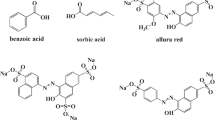Abstract
Some oxyhalides can be found in drinking waters as inorganic disinfection byproducts. An on-line coupled capillary isotachophoresis—capillary zone electrophoresis (CITP-CZE) method was developed for the analysis of chlorate, chlorite and bromate in water. The optimized CITP-CZE electrolyte system consisted of the following: 10 mM—HCl+20 mM—β-Alanine (leading electrolyte), 5 mM—succinic acid (terminating electrolyte), and 10 mM—succinic acid +5 mM—β-Alanine +0.1% HPMC (carrier electrolyte). A clear separation of oxyhalides from other components of drinking water was achieved within 25 min. Method characteristics, i.e., linearity (0–200 ng/mL), accuracy (88–110%), intra-assay (3–5%), quantification limit (5–15 ng/mL), and detection limit (2–5 ng/mL), were determined. Minimum labor requirements, sufficient sensitivity and low running cost are important attributes of this method. It was found that the developed method is useful for the routine analysis of oxyhalides in water.
Similar content being viewed by others
Abbreviations
- CITP-CZE:
-
on-line coupled capillary isotachophoresis with capillary zone electrophoresis
- IC:
-
ion chromatography
- BALA:
-
β-alanine
- EDA:
-
ethylenediamine
References
Swiss Analytical Handbook for Food, Chapter: Drinking water, Switzerland, 1986.
Guidelines for Drinking Water Quality, Vol. 1, Recommendations WHO, Geneva, 1993.
Ministry of Health of The Czech Republic: “Directive which sets requirements for drinking water quality, extent and frequency of its monitoring”, Register of Directives of The Czech Republic, item No. 376/2000 Sb., (2000).
ISO 15061:2001, Water quality—Determination of dissolved bromate—Method by liquid chromatography of ions, 2001, pp. 1–21.
U.S. EPA, Method 317.0: (2000), Determination of inorganic oxyhalide disinfection by-products in drinking water using ion chromatography with the addition of a postcolumn reagent for trace bromate analysis.
H. Weinberg: “Pre-concentration techniques for bromate analysis in ozonated waters”, J. Chromatogr. A, Vol. 671, (1994), pp. 141–149.
D. Kaniansky, I. Zelensky, A. Hybenova and F. Onuska: “Determination of chloride, nitrate, sulfate, nitrite, fluoride, and phosphate by online coupled capillary isotachophoresis-capillary zone electrophoresis with conductivity detection”, Anal. Chem., Vol. 66, (1994), pp. 4258–4264.
F. Kvasnička, M. Jaroš and B. Gaš: “New configuration in capillary isotachophoresis capillary zone electrophoresis coupling”, J. Chromatogr. A, Vol. 916, (2001), pp. 131–142.
Author information
Authors and Affiliations
About this article
Cite this article
Kvasnička, F., Janda, V., Rousová, D. et al. Determination of inorganic oxyhalides in drinking water by on-line coupled capillary isotachophoresis— capillary zone electrophoresis. cent.eur.j.chem. 3, 137–145 (2005). https://doi.org/10.2478/BF02476244
Received:
Accepted:
Issue Date:
DOI: https://doi.org/10.2478/BF02476244



